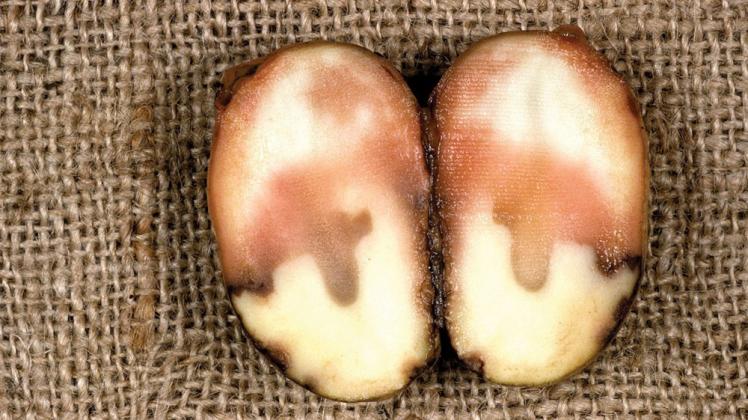Canadá: Canadian potato growers may lose Ridomil for pink rot
Phosphites offer growers a strong alternative control option for pink rot.

Canadian potato growers may be destined to lose the use of Ridomil to control pink rot.
The issue is most serious in Prince Edward Island, where observers say the active ingredient metalaxyl is on the verge of being rendered ineffective.
To some degree it is a looming problem across the country, according to a recent national survey. The AAFC-led initiative found 50 per cent of isolates in Ontario and points east showed resistance to the product, which also controls late blight and pythium leak in potatoes.
Rick Peters, a research scientist with Agriculture and Agri-Food Canada based in Charlottetown, P.E.I., told growers at Manitoba Potato Production Days in January the problem wasn’t as pressing for growers here — but that ignoring it would be an error.
“Resistance is skewed to Eastern Canada, and it’s just showing up in Western Canada now,” said Peters.
He said researchers first noticed resistance popping up in 2004 in New Brunswick. When pink rot hit P.E.I. growers hard in 2012, a national survey was initiated for 2013-14, which revealed both the eastern bias of the issue, and the fact there was a national resistance level of 39 per cent.
The survey, a collaborative effort between AAFC, Syngenta, Keystone Potato Producers Association, Potato Growers of Alberta and the PEI Potato Board, has just been renewed for a two-year term.
It also involves a project examining alternative management options for pink rot, based at AAFC’s Harrington Research Station near Charlottetown. Results will be published in 2017.
Phosphites
The pathogen in question is soil- and seed-borne, not airborne. According to Peters, the fungus develops resistance via overuse of Ridomil’s single-site mode of action — a scenario potato growers are all too familiar with, based on the loss of metaxyl to control much of the late blight infesting fields.
“Ridomil was the go-to product for many years, so like in late blight, once resistance started to appear, resistance began to dominate,” he said.
But an alternative mode of action for pink rot is already on the horizon. Peters’ team is studying the efficacy of three foliar or post-harvest phosphite products, registered in Canada under trade names Confine Extra, Phostrol and Ramparts.
In trials at Harrington, both products were highly effective at managing strains of the pink rot pathogen, said Peters, especially when used as a foliar treatment.
He recommends at least three applications through the season, of around two to 2-1/2 litres per acre, or seven to 10 litres per acre total, to achieve good disease control.
Phosphites offer good control because they are highly systemic and translocate down to the tubers, he said. An added bonus is the strong environmental profile of phosphites, relative to other chemistries.
But growers should avoid applying phosphites as an in-furrow seed treatment, said Peters.
“We like the foliar approach because it’s protecting right in the field and carries over to harvest,” he said. “And there are situations when post-harvest treatment can be helpful, such as when there’s a lot of risk at harvest, like bruising or wetness.”
Under wet conditions, pink rot produces a swimming spore that can move to the roots and tubers, and this active ingredient is effective at protecting those areas, Peters said.
“This is the only systemic product like this,” he said.
Applied post-harvest, phosphites also offer protection against silver scurf.
But Peters maintains that growers should be as proactive — and creative — as possible when it comes to managing or forestalling metalaxyl resistance.
“It’s a good idea to follow resistance management strategies — mixing or alternating products, using a broad-spectrum approach or non-chemical methods,” he said.
Growers should manage irrigation water and take care to avoid bruising and wounding tubers at harvest.
Samples of infected tubers should be sent to the provincial survey co-ordinator for forwarding to Peters’ lab. In Manitoba, provincial plant pathologist Vikram Bisht is the local contact.
Fuente: http://www.manitobacooperator.ca/news-opinion/news/canadian-potato-growers-may-lose-ridomil-for-pink-rot/




